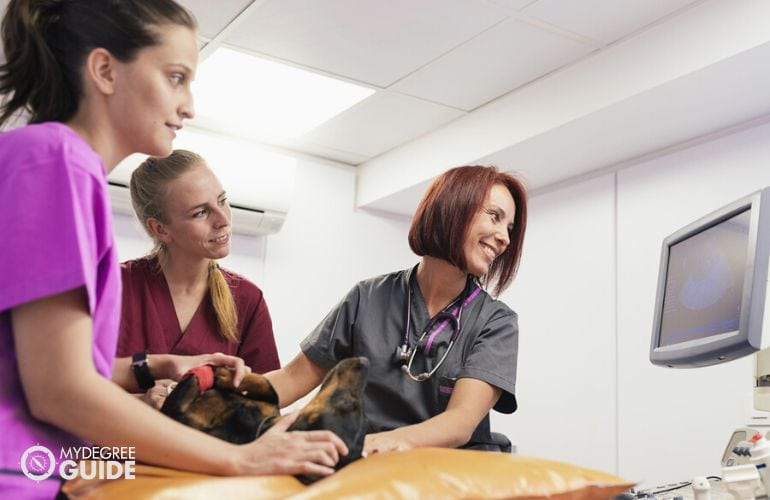If you love working with animals and are hoping to get into a career where you can do just that, you might consider vet assistant programs.

These certificate programs help prepare students to pursue jobs as vet assistants, where they can work directly with animals. In addition to coursework, these programs often involve opportunities for students to apply their knowledge in externships.
Editorial Listing ShortCode:
While postsecondary education is not always required for entry into vet assistant positions, it’s necessary to complete a vet assistant program in order to qualify for industry certification.
Online Vet Assistant Programs

Online vet assistant schools typically help teach students everything they need to know to pursue a career as a vet assistant. This can include learning how to perform basic veterinary tasks as well as communicating with customers and running office operations.
While enrolled in NAVTA-approved veterinary assistant programs online, students will likely study some of the following topics:
- Customer communication
- Long-term relationship building
- Animal nervous systems
- Maintaining medical records
- Medical calculations
- Pet health insurance
- Scheduling appointments
- Dental prophylaxis
- Animal husbandry
- Disease prevention
- Radiographic film processing
- Pet restraining techniques
In addition to classes covering these types of subjects, you may also get the chance to gain hands-on experience as a vet assistant. This typically comes in the form of an externship, where you would shadow and help out vet assistants in a veterinary office.
Editorial Listing ShortCode:
A NAVTA approved program can also help you qualify to become a certified veterinary assistant. After completing your certificate program, you could be eligible to take the Approved Veterinary Assistant (AVA) certification exam. While most graduates go on to become vet assistants, others may pursue related positions that work with animals.
For instance, some professionals work as animal caretakers, laboratory animal caretakers, animal trainers, and agricultural workers. With further education and training, they may pursue careers as veterinary technologists or technicians.
Vet Assistant Careers & Salaries

Upon completing vet assistant online programs, graduates most commonly choose to pursue certification and work as certified veterinary assistants.
These professionals help veterinarians with routine and administrative tasks, like cleaning kennels and bathing animals. Vet assistants may also administer medication, collect blood samples, and give emergency first aid to animals if needed. They can even help vets during surgeries by providing medical equipment and transporting animals.
According to the Bureau of Labor Statistics, here are the median salaries of veterinary support roles and related animal care positions.
| Careers | Annual Median Salaries |
| Animal Breeders | $45,320 |
| Vet Assistants and Lab Animal Caretakers — Scientific R&D Services | $43,780 |
| Vet Assistants and Lab Animal Caretakers — Postsecondary Schools | $41,080 |
| Animal Control Workers | $39,320 |
| Medical Secretaries and Administrative Assistants | $38,500 |
| Veterinary Technologists and Technicians | $38,240 |
| Animal Trainers | $35,620 |
| Vet Assistants and Lab Animal Caretakers — Veterinary Services | $34,380 |
| Receptionists and Information Clerks | $33,960 |
| Animal Caretakers | $29,530 |
Some graduates choose to pursue further education and training to become veterinary technologists and technicians. These professionals also help vets, and their day-to-day tasks can include administering anesthesia, restraining animals, and collecting records.
Editorial Listing ShortCode:
The Bureau of Labor Statistics projects that the demand for vet assistants and laboratory animal caretakers will grow by 19% over the next ten years, which is much faster than the average for all jobs.
Vet Assistant Certificate Curriculum & Courses

The curriculum for vet assistant programs online will vary depending on what school you enroll in, but here are a few examples of classes you may end up taking:
- Client Relations: You’ll learn how to effectively communicate with customers, including learning about how to use proper nonverbal communication.
- Introduction to Veterinary Assisting: This class teaches you basic responsibilities of the different roles in a vet’s office, along with safe and ethical practices.
- Animal Nursing: You’ll learn about various diseases that animals can catch as well as how they can get them and how to prevent this from happening.
- Veterinary Pharmacology: This course covers substances that are used in animal pharmaceuticals and basic math calculations vet assistants may need to use.
- Animal Anatomy and Physiology: You’ll learn about different parts of an animal’s body and how they affect each other, including the skin, fur, organs, and nervous system.
- Veterinary Radiology: This class dives into how to position animals for radiology exams and how to use the equipment and perform the tests.
- Veterinary Surgical Assisting: You’ll learn how to help vets perform animal surgeries, including monitoring anesthesia, prepping animals, and documenting the procedure.
- Medical Records: This course teaches students how to update and maintain accurate animal records and how to perform basic math calculations.
- Veterinary Business Practices: You’ll learn how to run a vet’s office, from assisting customers with vet insurance to scheduling appointments and retaining customers.
- Veterinary Dentistry and Critical Care: This class covers emergency and critical care for animals, and it teaches you how to analyze tough situations and administer the proper care.
In addition to classes like these, students may get the opportunity to participate in externships, typically at vets’ offices.
Veterinary Assistant School Admissions Requirements

While the admissions requirements for veterinary assistant schools vary by program, here are a few you may see:
- High school diploma or GED equivalent
- Interview
- Admissions assessment
Typically, the main requirement before applying to a vet assistant program is to have completed high school. Students who don’t have a high school diploma can supplement this requirement by providing a GED or credits from an associate’s program. Not every school requires an admissions assessment, but some may want to verify students can attend the program.
Online Veterinary Assistant Programs Accreditation

When choosing a school for your vet assistant program online, it’s beneficial to make sure it’s accredited by a recognized accrediting agency.
When a school holds accreditation, it means that a third-party accrediting organization has verified it meets certain academic quality standards. Attending these types of schools can be helpful when applying for federal financial aid. Also, you’re typically required to complete a training program from an accredited school to qualify for industry certification.
Editorial Listing ShortCode:
To verify a school’s accreditation status, you can visit the US Department of Education’s website.
Vet Assistant Licensure and Certifications

If you’re hoping to become a vet assistant, you may be interested in becoming certified as an Approved Veterinary Assistant (AVA). This certification is administered by the National Association of Veterinary Technicians in America (NAVTA).
While certification is optional for many vet assistants, becoming an AVA may advance your marketability as a job candidate or increase your chances of earning a higher salary. To qualify to take the AVA certification exam, it’s necessary to first complete a vet assistant program that’s approved by NAVTA. Most vet assistant certificate programs are designed to prepare you for the certification exam.
Financial Aid and Scholarships

If you’re wanting to apply for financial assistance to help pay for a vet assistant program, you can explore all the options offered by the US Department of Education on the Federal Student Aid website.
To begin the application process for a government student loan, you can fill out the Free Application for Federal Student Aid form. Your school will then be able to figure out how much money you may be eligible to receive if you qualify. You may also be able to apply for grants, scholarships, work-study programs, and more. Some employers also offer tuition benefits to employees to encourage professional development.
What Can You Do with a Veterinary Assistant Certificate?

After completing a vet assistant program, graduates most commonly go on to pursue work as veterinary assistants.
While a high school diploma is often the minimum educational requirement for this position, a NAVTA approved vet assistant program can help you qualify for industry certification. Becoming certified may help you increase your marketability as well as your earning potential.
Graduates from a vet assistant program may also choose to explore other occupations that work with animals. Related positions include animal caretakers, laboratory animal caretakers, animal control workers, and animal trainers.
With further education and training, graduates may choose to pursue careers as veterinary technologists or technicians.
What Do Vet Assistants Do?

Vet assistants perform a wide range of tasks that help support veterinarians in their offices. These can include administrative jobs like scheduling appointments, coordinating pet insurance for owners, maintaining animal records, and more.
These professionals may also assist with performing basic veterinary duties directly with animals. These tasks can include cleaning equipment, restraining pets during appointments, observing surgeries, grooming animals, and more. In some cases, vet assistants may help administer urgent care during certain types of emergencies.
How Much Do Vet Assistants Make?

According to the Bureau of Labor Statistics, the median annual salary for veterinary assistants and laboratory animal caretakers is $34,740. Most make between $25,270 and $44,920 each year. Becoming certified as an Approved Veterinary Assistant (AVA) may increase your overall earning potential as a vet assistant.
Related occupations have similar wages. For instance, the median salary for animal caretakes is $29,530, and the median for animal trainers is $35,620. Animal control worker is another related career path. This profession has a median salary of $39,320.
How Long Does It Take to Get an Online Vet Assistant Certificate?

The timeframe for completing veterinary assistant online programs can vary, but an undergraduate certificate generally takes less time to earn than a degree.
Editorial Listing ShortCode:
Some vet assistant certificate programs take up to 1 year or 1.5 years to complete. Others, though, are designed to be completed in as little as 9 months. Whether you enroll full-time or part-time can also affect how long it takes you to complete your program.
What’s the Difference Between a Vet Tech vs. Vet Assistant Profession?
Veterinary technicians and vet assistants both help support veterinarians, but they may do so in a few different ways. Here are some common tasks for each.
| Vet Tech Assistants | Veterinary Assistants |
|
|
In general, veterinary technicians may work more closely with animals, while vet assistants may help with more administrative and clerical tasks. Becoming a vet technician also requires an associate degree, while a vet assistant may only have a high school diploma or undergrad certificate.
What’s the Difference Between a Veterinary Assistant Certification vs. Certificate?
A veterinary assistant certification is a professional credential, while a vet assistant certificate is an academic credential. Here are some more differences between them.
| Vet Assistant Certification | Vet Assistant Certificate |
|
|
A NAVTA approved certificate program can help you prepare for industry certification.
Is a Vet Assistant Training Worth It?

Yes, a vet assistant training is worth it for many students. If you love working with animals, you may enjoy learning about a field where you get to do just that every day.
If you want to get your foot in the door in the veterinary field, training to be a vet assistant is one of the quickest ways to take the first step toward that goal. A vet assistant training program that’s approved by NAVTA can also prepare you for industry certification.
Editorial Listing ShortCode:
The Bureau of Labor Statistics projects 19% job growth for vet assistants and laboratory animal caretakers over the next ten years, which is much faster than average.
Universities Offering Online Veterinary Assistant Certificate Programs
Methodology: The following school list is in alphabetical order. To be included, a college or university must be regionally accredited and offer programs online or in a hybrid format.

Auburn University offers an online Veterinary Assistant Professional Development Certificate program. Topics of study include animal care, client interactions, and administrative duties. The online courses include animated simulations, engaging labs, and collaborative activities. The program offers around-the-clock tech support. Graduates usually go on to work in animal hospitals, boarding facilities, and similar settings.
Auburn University is accredited by the Southern Association of Colleges and Schools.

The Borough of Manhattan Community College offers a veterinary assistant course. There are no prerequisites to take this fully online course. The curriculum covers topics such as front office duties, canine and feline restraint, giving medications, vaccinology, client communications, and handling medical records.
BMCC is accredited by the Middle States Commission on Higher Education.

California State University – Chico offers a fully online veterinary assistant career training program. The curriculum covers basic tasks, such as clerical duties, pet feeding and nutrition, and how to check vital signs. The course does not require any prerequisites and can be started at any time.
California State University – Chico is accredited by the WASC Senior College and University Commission.

San Diego State University offers a 100% online veterinary assistant training course that may be started at any time and typically finished in 6 months or less. The curriculum covers topics such as basic animal anatomy and physiology, front office duties, animal restraint, workplace hazards, and how to administer medications.
San Diego State University is accredited by the WASC Senior College and University Commission.

The University of North Dakota offers a 100% online veterinary assistant training program that may be started at any time. The curriculum covers topics such as medical records handling, client communication, and animal examination and restraint procedures.
The University of North Dakota is accredited by the Higher Learning Commission of the North Central Association of Colleges and Schools.
Getting Your Vet Assistant Certificate Online

If you’re excited about the idea of becoming a vet assistant, getting your certificate online can be a beneficial way to get started. These programs typically take 9 months to 1.5 years to complete. A NAVTA approved program can help you prepare for industry certification.
You can learn about topics like customer communications, animal nervous systems, pet restraining techniques, and more. Most programs also provide some type of opportunity for students to practically apply their knowledge under a veterinarian’s supervision.
If you’re ready to earn your vet assistant certificate online, you can start exploring accredited schools today to see which programs stand out to you.

